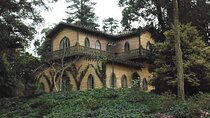Tours in Sintra
Private Day Tour from the Centre to the Highest Point in Sintra.
Lisbon Private Transfers (MInibuses 8pax)
Explore Mystical Regaleira and taste Sintra´s delicacies
Just half an hour from Lisbon, the city's exhausting heat gives way to a mountain microclimate, and time seems to move in the opposite direction - this is the effect the city of Sintra has on the traveler. Portugal, thanks to its compact size, is full of surprises that await the tourist everywhere, but the royal gift is Sintra. The guide will call it the City of Palaces or the Garden of Europe, and you can see for yourself that it deserves these titles.
You can imagine a place with thousands of years of history, mountainous terrain, a mix of cultural traditions of different nations and its own culinary peculiarities - that would be Sintra. What to see and what not to miss is best told by the locals - many of whom used to work as gardeners and governesses in rich estates, so they know palace life from the inside.
While still a fortress, Sintra was the residence of Portuguese kings from 1147, and a few years later the fortress was replaced by a town. The life of the rulers from the 15th to the end of the 19th century is commemorated by the National or Royal Palace, which has been preserved within the city. Sintra is primarily associated with its white chimneys and the distinctly Moorish cut of its windows and arches. However, there are also more tangible signs of the former Arab domination in the city, the most important of which is the mountain fortress - the Castle of the Moors. Sintra fascinates with its cinematography, and these mighty fortifications that wind along the crest of the hill have been filmed in more than one movie. Filmmakers and romantics are also drawn to another local attraction, Sintra's Pena Castle. King Fernando II had it built for his beloved and surrounded by a magnificent garden as soon as he got Sintra. The Pena Palace became one of Portugal's main attractions, and also set the fashion for exotic plants brought from far away to be grown in large quantities by prominent landowners.
Today it is a favorite destination for celebrities and the rich, drawn by Sintra's golden beaches, mountain air and centuries-old atmosphere of aristocratic frivolity. You can easily meet some of them in the morning in the town's cafes, or turn the corner and stumble upon a movie set. Sintra has long and skillfully played its role as a fairy-tale town: Hans-Christian Anderson recalled that the time he spent here gave him many new images and characters. The locals never stop telling stories of ghosts inhabiting the abandoned houses, and it's almost believable here. The palace of Quinta de Rigaleira is also full of mystical stories. Sintra (Portugal - the birthplace of one of the oldest Masonic obedience) attracted many aristocrats, and among them was a member of the Masonic Lodge, the philanthropist Monteiro, who bought this estate at the end of the XIX century and embodied in it his ideas about the order of the universe. For example, the Well of Initiation, a spiral gallery that goes deep into the earth, became one of the most mysterious local attractions.
Since the city is also known for its pastry shops, where the monks originally experimented, a gastronomic excursion should certainly be on everyone's agenda: Sintra is famous for its desserts.
Drowned in the green of unprecedented plants, the city was called "the glorious Eden" by Byron. It is not surprising, therefore, that this paradise is located at the edge of the world, just a few kilometers from the city of Sintra. Cape Roca is the extreme point of the European world, left behind by brave Portuguese navigators as they set out in search of unknown lands in the open ocean.




